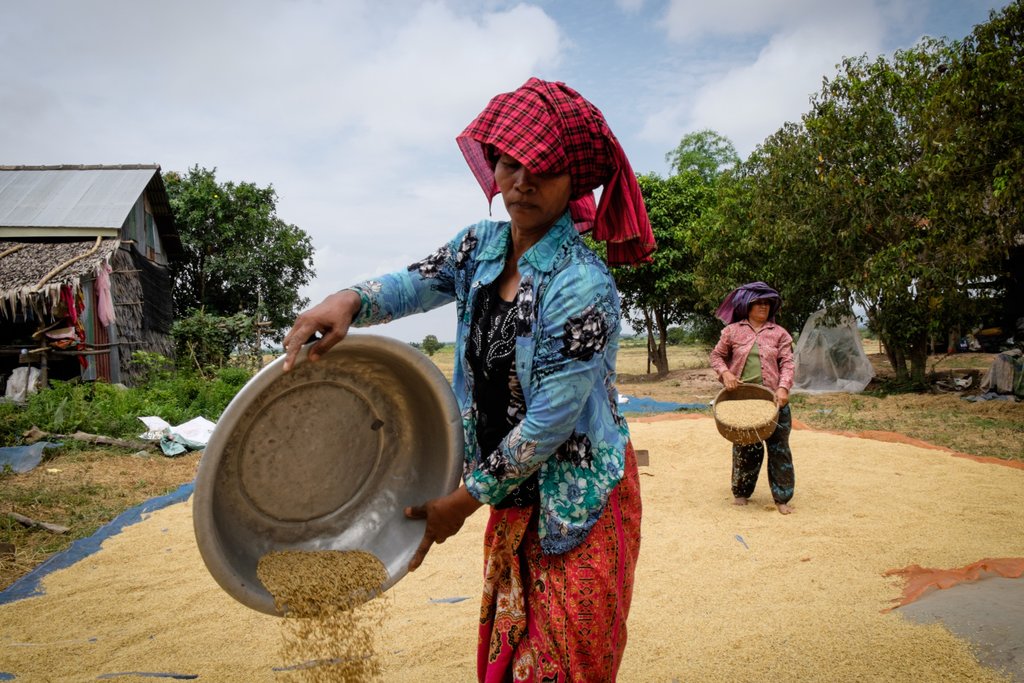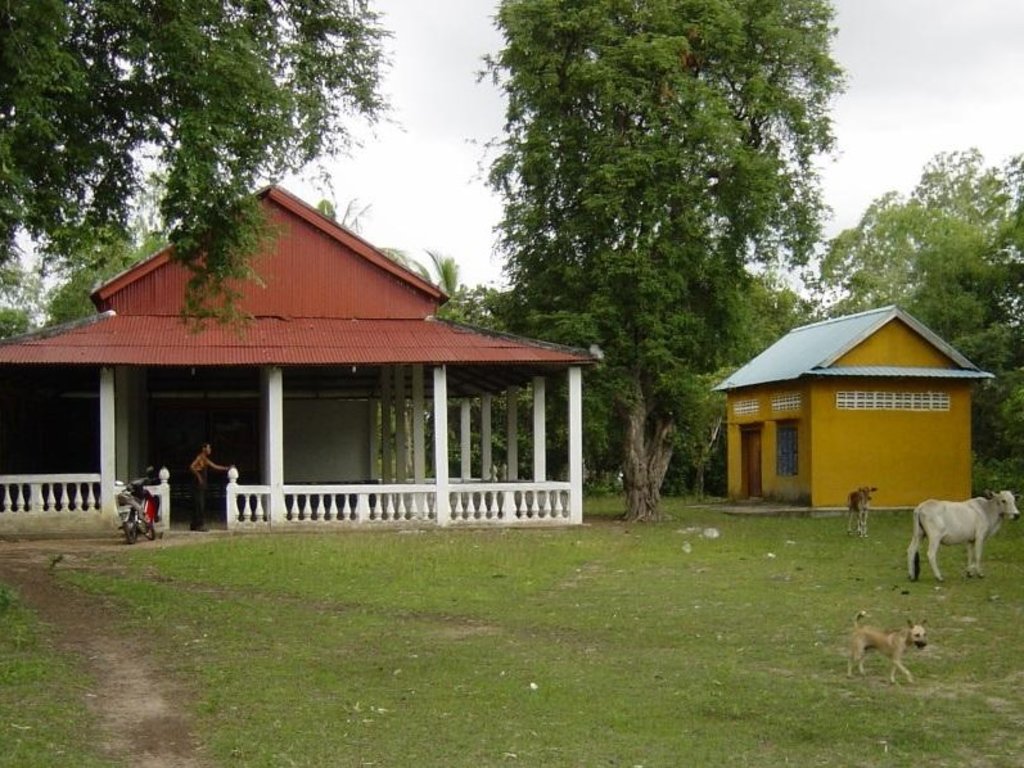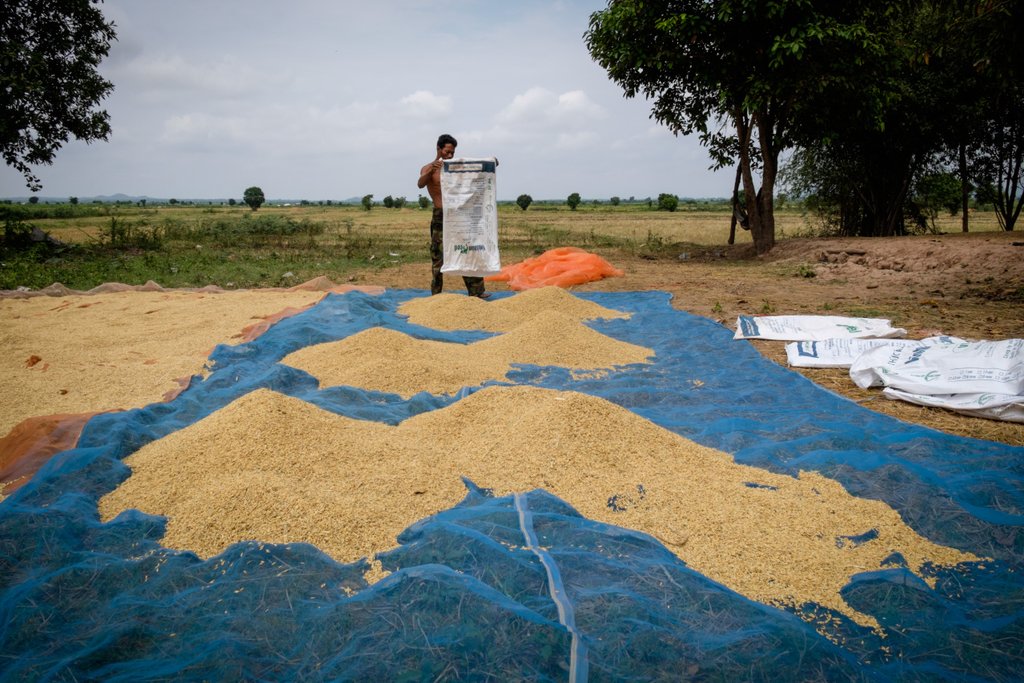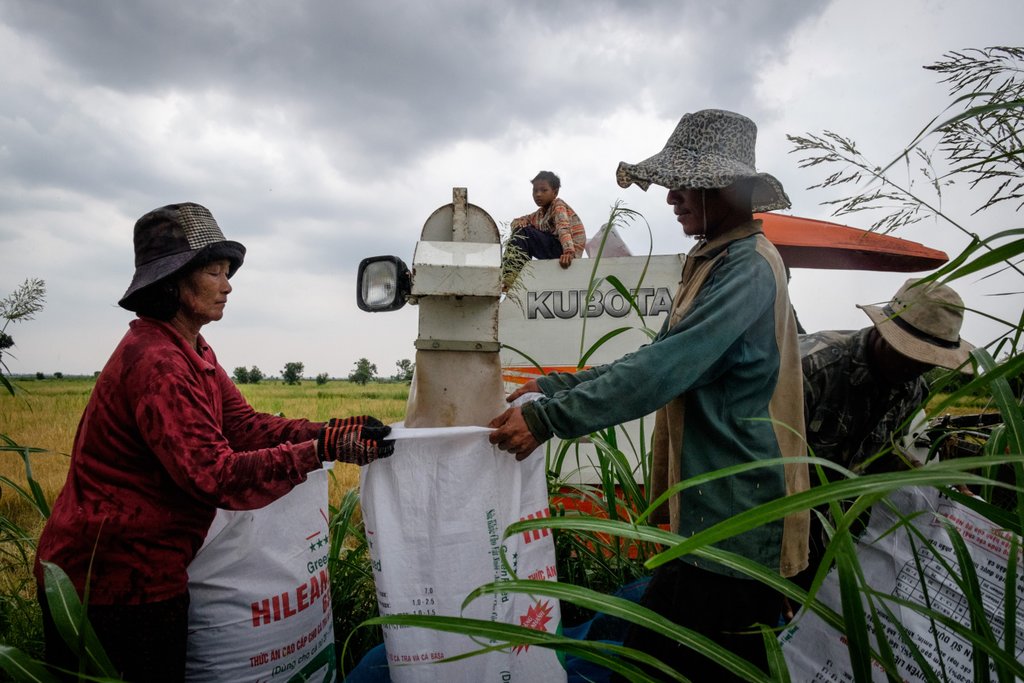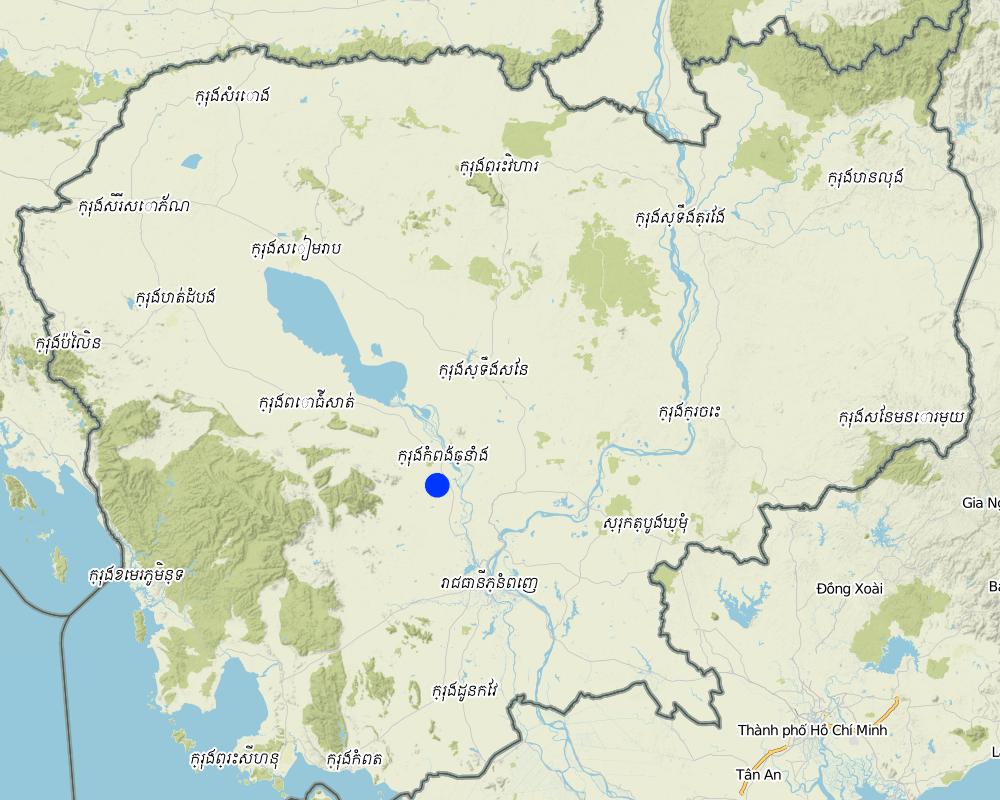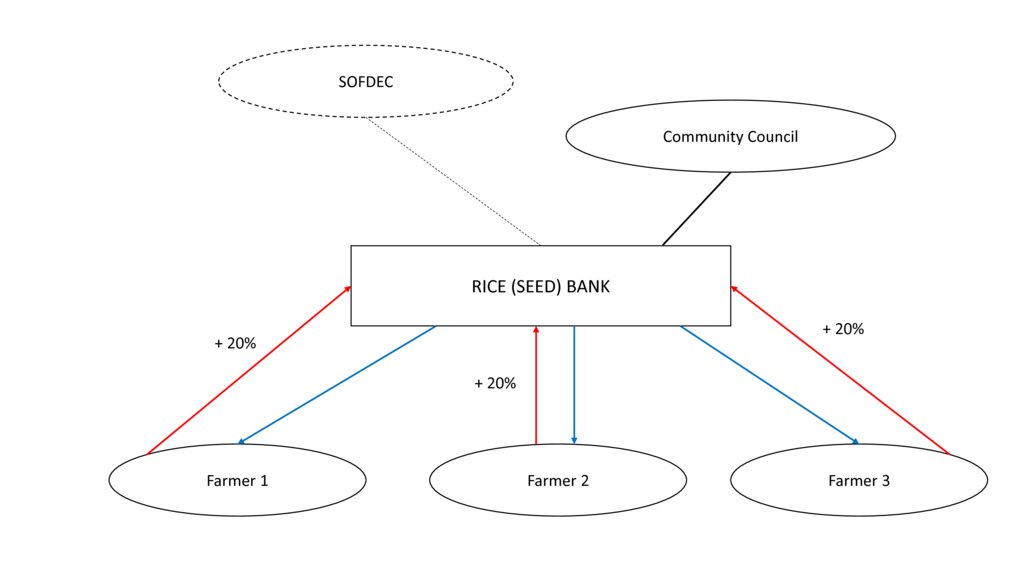Community Safety Nets - Establishment of rice seed banks at village level [Camboja]
- Criação:
- Atualização:
- Compilador/a: Judith Macchi
- Editores: Stefan Graf, Christoph Kaufmann, Christine Lottje
- Revisores: Boris Orlowsky, Alexandra Gavilano
approaches_1848 - Camboja
Veja as seções
Expandir tudo Recolher tudo1. Informação geral
1.2 Detalhes do contato das pessoas capacitadas e instituições envolvidas na avaliação e documentação da abordagem
Pessoa(s) capacitada(s)
Especialista em GST:
Khun Lean Hak
kleanghak@yahoo.com / sofdec@camintel.com
SOFDEC/LAREC
Camboja
Especialista em GST:
Bin Sreytouch
Society for Community Development in Cambodia SOFDEC
Camboja
Say Mesa
Society for Community Development in Cambodia SOFDEC
Camboja
Especialista em GST:
Pit Khonhel
Local Agriculture Research and Extension Centre LAREC
Camboja
Nome do projeto que facilitou a documentação/avaliação da Abordagem (se relevante)
Book project: where people and their land are safer - A Compendium of Good Practices in Disaster Risk Reduction (DRR) (where people and their land are safer)1.3 Condições em relação ao uso da informação documentada através de WOCAT
Quando os dados foram compilados (no campo)?
16/04/2014
O/a compilador/a e a(s) pessoa(s) capacitada(s) aceitam as condições relativas ao uso de dados documentados através da WOCAT:
Sim
2. Descrição da abordagem de GST
2.1 Descrição curta da abordagem
A rice (seed) bank is a community safety net system where farmers can get both rice seeds for cultivation and rice for consumption from a communal storage house in order to increase their food security by guaranteeing: (1) year-round access to high quality seeds and rice for consumption, (2) access to seed and rice for consumption after an extreme weather event (drought, flood) and (3) improved quality of the planted seeds through the provision of new varieties better adapted to local conditions (e.g. fast maturing, floating rice)
2.2 Descrição detalhada da abordagem
Descrição detalhada da abordagem:
A rice (seed) bank is a system where farmers can get both high quality rice seeds for planting and rice for consumption from a communal storage house. Requirement for the use of the rice (seed) bank is that farmers pay back the purchased rice seeds or rice for food with a 20% interest rate after their next harvest. The bank is managed by a community council consisting of members of the village in collaboration with the local NGO Society for Community Development in Cambodia - SOFDEC.
The rice (seed) banks act as a community safety net in the villages to guarantee food security despite the threat of extreme weather events such as drought or flood. Because of the constant access to high quality seeds, farmers can sow a second time in case the first sowing was lost due to a drought or flood. Also, the communal storage of rice for consumption helps particularly poor farmer families with small plots in case they do not get enough yield on their field to feed the household.
Moreover, new rice varieties, which are better adapted to local conditions and which also perform in the case of extreme weather (fast maturing, floating rice) are introduced through the rice (seed) bank. Besides these new varieties (the result of research carried out by the Local Agricultural Research and Extension Center LAREC in collaboration with other research institutes) have higher yields and can also be sold at a better price on the market.
The need for a rice (seed) bank is decided in participatory manner by the village community. In case a bank is established it is managed by a community council of elected community members. The council is responsible for the storage, the distribution and supervises the back payment of the rice (seed). Through the collaboration between the Community Council and SOFDEC, new SLM Technologies such as the System of Rice Intensification can be promoted in the target villages.
The stages of implementation are as follows:
1. SOFDEC consults with the villagers about the aim and the need for a rice (seed) bank. Generally, rice banks are established if farmers express that there is a high exposure to extreme weather event, low food security and/or rice seeds are of bad quality (bad germination, low yields).
2. The decision about the establishment and implementation of a rice (seed) bank is made by the village community.
3. A Community Council is elected by the villagers and trained on their role and functioning of the rice (seed) bank by SOFDEC staff.
4. The communal storage is built. Building materials are provided by SOFDEC, the community contributes with labor.
5. SOFDEC provides a first stock of high quality rice seeds from LAREC and rice for consumption.
6. After the first harvest, the farmers pay back the seeds and rice consumed with a 20% interest rate.
7. SOFDEC monitors the functioning of the rice seed banks and takes a mediating role in case that problems between the community council and the village community arises.
2.3 Fotos da abordagem
2.5 País/região/locais onde a abordagem foi aplicada
País:
Camboja
Região/Estado/Província:
Kampong Chhnang
Especificação adicional de localização:
Different districts
Comentários:
There are 11 rice banks in the area, benefitting 11 villages. The Society for Community Development in Cambodia (SOFDEC) has been implementing rice banks in different villages of Kampong Chhnang Province since 2000.
Map
×2.6 Datas de início e término da abordagem
Indique o ano de início:
2000
2.7 Tipo de abordagem
- Baseado em projeto/programa
2.8 Principais metas/objetivos da abordagem
The main aim of the approach is to increase the resilience of farmer families by improving their food security (rice seeds and rice for food are now available the whole year round, mutual support after droughts or floods possible), increasing their income (rice varieties higher yielding) as well as strengthening local institutions (community committees manage the rice banks, and participate in decision making on a local level).
2.9 Condição que propiciam ou inibem a implementação de tecnologia/tecnologias aplicada(s) segundo a abordagem
Normas e valores sociais/culturais/religiosos
- Propício
Willingness of the community to support each other through a safety-net system
- Inibitivo
Some farmers are reluctant to be part of the rice (seed) bank, as they do not want to use/consume someone else's rice, which might be of different quality than his/her own
Disponibilidade/acesso a recursos e serviços financeiros
- Propício
First inputs for the establishment of the rice (seed) banks are provided by the project (materials for the building of the bank, improved and locally adapted rice seed from LAREC)
- Inibitivo
Some farmers struggle to repay the amount of rice borrowed including the requested interest rate of 20%, particularly after an extreme weather event (drought, flood)
Colaboração/coordenção de atores
- Propício
Rice (seed) banks are decided upon and managed by the community itself through an elected community council
Conhecimento sobre GST, acesso a suporte técnico
- Propício
Through research done by the Local Agricultural Research and Extension Center LAREC, the rice varieties in the rice banks are adapted to the needs of the farmers (e.g. higher yielding, short breeding, drought resistant). Through the SOFDEC programme farmers are furthermore capacitated in new cultivation techniques (such as System of Rice Intensification - SRI).
- Inibitivo
Lack of technical knowlegde on high quality seed multiplication leads to rice seed supply of bad quality in the rice bank.
3. Participação e papel das partes interessadas envolvidas
3.1 Partes interessadas envolvidas na abordagem e seus papéis
- Usuários de terra/comunidades locais
Farmers
Farmers can borrow rice seed and in case of a disaster also rice for consumption from the rice bank. After their next harvest the farmers have to pay back the rice (seed) borrowed with a 20% interest
- Organizações comunitárias
Community council
Community Councils are elected by the community and are managing the rice banks and make sure that the regulation are met by the farmers participating in the rice banks
- Organização não governamental
Society for Community Development in Cambodia - SOFDEC
SOFDEC is responsible for the planning and design of the approach, implementation of rice banks as well as for the financing of the initial establishment of the rice banks.
- Governo local
village chief
The village chief facilitates the introduction of the rice seed bank in the community and supports the community council in the steering of the banks as well as when facing problems within the village concerning the bank.
Furthermore, the village chief has to verify and acknowledge land acquisation documents land for rice bank construction and by-laws.
Caso várias partes interessadas foram envolvidas, indique a agência líder:
SOFDEC
3.2 Envolvimento do usuários de terra/comunidades locais nas diferentes fases da abordagem
| Envolvimento do usuários de terra/comunidades locais | Especifique quem estava envolvido e descreva as atividades | |
|---|---|---|
| Iniciação/motivação | Participativo | Land users are consulted regarding their needs for the establishment of a rice bank. |
| Planejamento | Passivo | The planning and design of the rice banks is carried out by SOFDEC staff. |
| Implementação | Apoio externo | Implementation of the banks is done by SOFDEC in consultation with the land users. SOFDEC finances the materials for the establishment of the rice banks, whereas the community contributes with their labor. Community agrees on the regulations (by-laws) for the implementation of the rice banks. |
| Monitoramento/avaliação | Participativo | SOFDEC initially monitors the functioning of the rice banks (3-4 years after establishment). The community council is responsible for the everyday monitoring of the banks (e.g. participating farmers adhere to the regulations agreed on by the community). |
| research | Passivo | Research for improved locally adapted rice varieties (fast maturing, floating rice) is done by Local Agricultural Research and Extension Center- LAREC in collaboration with other research institutions. The improved seed developed by LAREC is stocked in the rice seed banks. |
3.3 Fluxograma (se disponível)
Descrição:
Rice (seed) banks are established on a village level after consultation with the local farming community. The banks are managed by an elected community council. Farmers take out rice seed or rice for consumption (in case of an emergency) and pay back the amount of rice (seed) with an interest rate of 20%.
SOFDEC facilitates the establishment of the rice seed banks and provides the material for the building of the rice seed bank as well as the first supply of rice seed.
Autor:
HEKS
3.4 Decisão sobre a seleção de tecnologia/tecnologias de GST
Especifique quem decidiu sobre a seleção de tecnologia/tecnologias a serem implementadas:
- Principalmente usuários da terra, apoiados por especialistas em GST
- n.a.
4. Suporte técnico, reforço das capacidades e gestão do conhecimento
4.1 Reforço das capacidades/ formação
Foi oferecida formação aos usuários da terra/outras partes interessadas?
Sim
Especifique quem foi capacitado:
- Usuários de terra
Caso seja relevante, especifique gênero, idade, status, etnia, etc.
Community Councils and participating farmers
Tipo de formação:
- Em exercício
Assuntos abordados:
Community councils were trained on functioning and administration of the rice bank. Farmers were trained on the multiplication and collection of rice seeds.
4.2 Serviço de consultoria
Os usuários de terra têm acesso a um serviço de consultoria?
Sim
- n.a.
Descreva/comentários:
Knowledge exchange between the land users and SOFDEC staff.
Knowledge exchange between SOFDEC and the Provincial Department of Agriculture.
4.3 Fortalecimento da instituição (desenvolvimento organizacional)
As instituições foram fortalecidas ou estabelecidas através da abordagem?
- Sim, moderadamente
Especifique a que nível (níveis) as instituições foram fortalecidas ou estabelecidas:
- Local
Descreva instituição, papéis e responsabilidades, membros, etc.
Community Councils
Especifique o tipo de apoio:
- Reforço das capacidades/ formação
4.4 Monitoramento e avaliação
Monitoramento e avaliação são partes da abordagem?
Sim
Comentários:
Everyday monitoring is ensured by the community council.
For the first 3-4 years after the establishment, SOFDEC monitors the implementation and functioning of the rice banks.
Monitoring aspects:
- No. of members, kg of rice taken out of the bank and payed back to the bank
- General attitude towards the rice bank (are the pay back mechanisms adhered to, etc.)
- Amount of yields and quality of rice (seeds), sometimes optimized
Caso afirmativo, esta documentação é destinada a ser utilizada para monitoramento e avaliação?
Sim
4.5 Pesquisa
A pesquisa foi parte da abordagem?
Não
5. Financiamento e apoio material externo
5.1 Orçamento anual para o componente de GST da abordagem
Caso o orçamento exato seja desconhecido, indique a faixa:
- 2.000-10.000
5.2 Apoio financeiro/material concedido aos usuários da terra
Os usuários da terra receberam apoio financeiro/material para a implementação de tecnologia/tecnologias?
Sim
Caso afirmativo, especifique tipo(s) de apoio, condições e fornecedor(es):
The project provides the materials for for rice bank construction.
5.3 Subsídios para entradas específicas (incluindo mão-de-obra)
- Agrícola
| Especifique quais entradas foram subsidiadas | Em que medida | Especifique os subsídios |
|---|---|---|
| Sementes | Totalmente financiado | Rice seeds for the first season after the implementation of the rice bank is provided by the project. |
- Construção
| Especifique quais entradas foram subsidiadas | Em que medida | Especifique os subsídios |
|---|---|---|
| Pedra | Totalmente financiado | All construction materials for the rice bank building is provided by the project. Type of construction (wood or stone) varied depending on the preferences of the village community. |
| Madeira | Totalmente financiado | All construction materials for the rice bank building is provided by the project. Type of construction (wood or stone) varied depending on the preferences of the village community. |
Se a mão-de-obra pelos usuários da terra foi uma entrada substancial, isso foi:
- Voluntário
Comentários:
Land users supported the establishment of the rice seed banks with their labor.
5.4 Crédito
Foi concedido crédito segundo a abordagem para atividades de GST?
Não
5.5 Outros incentivos ou instrumentos
Foram utilizados outros incentivos ou instrumentos para promover a implementação das tecnologias de GST?
Não
6. Análise de impactos e declarações finais
6.1 Impactos da abordagem
A abordagem auxiliou os usuários da terra a implementar e manter as tecnologias de GST?
- Não
- Sim, pouco
- Sim, moderadamente
- Sim, significativamente
Farmers have access to seed varieties which are adapted to local conditions (e.g. drought and flood resistance), ensuring that yields are also generated in case of an extreme weather event.
A abordagem concedeu autonomia aos grupos social e economicamente desfavorecidos?
- Não
- Sim, pouco
- Sim, moderadamente
- Sim, significativamente
Rice (seed) banks are open to everybody. Thus, economically disadvantaged land users and ethnic minorities participate in rice banks. The rice banks function as safety nets in cases of extreme weather (e.g. droughts, floods) or economic despair.
A abordagem resultou em segurança alimentar aprimorada/nutrição melhorada?
- Não
- Sim, pouco
- Sim, moderadamente
- Sim, significativamente
The rice banks offer year round access to high quality rice seed and rice for consumption all year round and also during extreme weather events. This allows farmers to sow out again in case one harvest gets lost. The rice bank also benefits farmers with small land plots – they might sell all their yields of new varieties on the market and buy with the return conventional rice for consumption, which is cheaper.
A abordagem aprimorou a capacidade dos usuários da terra de adaptar-se a mudanças climáticas/extremos e atenuar os desastres relacionados com o clima?
- Não
- Sim, pouco
- Sim, moderadamente
- Sim, significativamente
Increased resilience to extreme weather events because of the availability of both seeds and rice for consumption. Moreover, the seed varieties stored in the rice bank is adapted to local conditions (e.g. fast maturing, floating rice), ensuring that yields are also generated in case of an extreme weather event.
A abordagem resultou em emprego, oportunidades de renda?
- Não
- Sim, pouco
- Sim, moderadamente
- Sim, significativamente
The new varieties promoted through the rice banks have higher yields, thus leading to more income for the farmers. Farmers also get higher prices on the market for the new rice varieties.
6.2 Principal motivação dos usuários da terra para implementar a GST
- Produção aumentada
- Riscos de desastre reduzido
- well-being and livelihoods improvement
6.3 Atividades de sustentabilidade de abordagem
Os usuários da terra podem manter o que foi implementado através da abordagem (sem apoio externo)?
- Sim
Caso afirmativo, descreva como:
Initial coaching by SOFDEC is needed, however, after 3 years the rice banks function without any external support.
6.4 Pontos fortes/vantagens da abordagem
| Pontos fortes/vantagens/oportunidades na visão do usuário da terra |
|---|
| The rice banks offer access to high quality seeds to all farmers in the community. |
|
Increased food security and resilience due to the permanent availability of rice seeds or rice for consumption. |
| More income due to higher yields and better prices for new varieties. |
| After about 3-4 years, the banks mostly work independently. |
6.5 Pontos fracos, desvantagens da tecnologia e formas de superá-los
| Pontos fracos/desvantagens/riscos na visão do usuário da terra | Como eles podem ser superados? |
|---|---|
| Limited amount of rice (seed) to be borrowed. | Increase the storage capacity and conditions. |
| Required technical and managerial knowledge for the community councils is high. | Regular training sessions by SOFDEC |
| Rodents or insects might destroy the rice. | Apply narrow-mash nets to protect the rice from rodents and other animals |
| Some farmers do not comply with the required interest rates, delays in payback, etc. | Make a contract with them, decide on a step by step pay back manner, or if the farmer is not able repay (sick family member, loss of land, etc.) the whole group can decide to waive the debts |
| Pontos fracos/vantagens/riscos na visão do/a compilador/a ou de outra pessoa capacitada | Como eles podem ser superados? |
|---|---|
| Seeds are treated with pesticides to make them last. | Improve the storage conditions or use different techniques to prevent pests (Integrated Pest Management IPM) |
| Only rice is considered. | Introduce a similar approach also for other plants in order to diversify the farmers’ income. Allow the farmer to pay back with other crops or varieties. |
7. Referências e links
7.1 Métodos/fontes de informação
- visitas de campo, pesquisas de campo
- entrevistas com usuários de terras
- compilação de relatórios e outra documentação existente
7.3 Links para informação relevante que está disponível online
Título/ descrição:
The Society for Community Development in Cambodia (SOFDEC) is a Cambodian Non-Governmental Organization, established in 2006 through the localization of HEKS (the Swiss Church Aid) project in Kampong Chhnang province, Cambodia. The vision of SOFDEC is that Cambodian people living in Cambodia live a state of comfort, equality, equity, and have ownership over the sustainable development of their community. The mission of SOFDEC works in partnership with community based organizations and relevant institutions through integrated community development, research, human resource development, enhancement of family economies, in the hopes to uplift the living standards of the people in the target areas. Our goal aims to uplift the living standards of the rural people of Cambodia through the improvement in income generation, sustainable agricultural practices, microfinance, health, human resource development, and sustainable natural resource management.
URL:
www.sofdec.com
Links e módulos
Expandir tudo Recolher tudoLinks
Não há links
Módulos
Não há módulos



